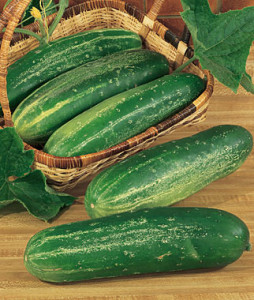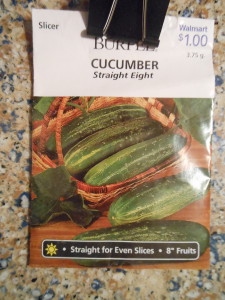Cucumber:
Cucumbers have always been a staple in my gardens. They are relatively easy to grow, if handled right are big producers and cucumbers are able to be eaten fresh, added to recipes and they store well as pickles.
This year I planted 10 feet of cucumbers. I chose 1 type to plant. It was a “slicing” cucumber. I chose Burpee’s Straight Eight. The Advertising for these cucumbers states:
A cucumber superstar, this classic has excellent flavor and is widely adapted.
This heirloom, All-America Selections winner is a cuke for all  seasons. Pick when 8″ long for top flavor. For perfect cukes, grow them on a fence or our space-saving Trellis Netting. Sow seeds 6″ apart in rows, or plant 5 or 6 seeds in groups (hills) 4 to 5′ apart.
seasons. Pick when 8″ long for top flavor. For perfect cukes, grow them on a fence or our space-saving Trellis Netting. Sow seeds 6″ apart in rows, or plant 5 or 6 seeds in groups (hills) 4 to 5′ apart.
Sun: Full Sun
Height: 6-8 inches
Spread: 36 inches
Days to Maturity: 58 days
Sowing Method: Direct Sow
Fruit Size: 6-8 inches
I planted 10 feet of straight eights – 4 mounds of 2 plants each. I found the Burpee straight eight to be a very good cucumber. Fantastic taste and prolific. One issue we had with them is if we let them go a week extra, we would need to scrape out the seeds since they started to take over the cucumber.
We started the cucumbers in mid-May in the green house in large seed pots filled with starter soil. They were not planted until the second week of June when the plants already had 3 sets of leaves. I set up a plastic wide-mesh fence so the plants could climb. As far as fertilizer, we used miracle grow 10-10-10 – 3 times during the season. We had no issues with pests and in-fact honey bees were common the entire summer around the “cukes”, something that made me happy since for the last five or so years seeing honey bees in any quantity has become very rare. I try not to use chemicals and in late September we lost all the cucumbers to powdery-mildew. So, word to the wise – beware.
We ended up picking 32lbs. over the season. Almost all eaten or given to the “kids” In accordance with my garden book written by James Underwood Crockett – that is a decent average for the amount I planted.
Some Cucumber Info:
Description
Even though long, dark green, smooth-skinned garden cucumbers are familiar vegetables in the produce sections of most groceries, cucumbers come in a wide variety of colors, sizes, shapes and textures. You’ll find white, yellow, and even orange-colored cucumbers, and they may be short, slightly oval, or even round in shape. Their skins can be smooth and thin, or thick and rough. In a technical sense, cucumbers are actually fruits, not vegetables.
All cucumbers belong to the botanical plant family called Curcubitaceae. This broad family of plants includes melons and squashes.
 While there are literally hundreds of different varieties of cucumbers, virtually all can be divided into two basic types: slicing and pickling. Slicing cucumbers include all varieties that are cultivated for consumption in fresh form. Pickling cucumbers include all varieties that are cultivated not for consumption in fresh form, but for processing into pickles.
While there are literally hundreds of different varieties of cucumbers, virtually all can be divided into two basic types: slicing and pickling. Slicing cucumbers include all varieties that are cultivated for consumption in fresh form. Pickling cucumbers include all varieties that are cultivated not for consumption in fresh form, but for processing into pickles.
Growing Cucumbers
Cucumbers are fairly easy to grow if you take care of a few things:
1. They like a fairly neutral soil.
2. They are heavy feeders so when planting make sure to add either: compost, well rotted manure, some grass clippings or anything that will help provide nourishment for the plants.
3. They need water so make sure to provide plenty and if you keep the water off the leaves all the better to avoid powdery-mildew.
4. You can double crop cucumbers. Start the second sowing in late June in pots. By late July pick all cucumbers from 1st crop, pull out plants, add some 10-10-10 or 5-10-10 fertilizer and plant the young plants. This should give you a good crop by Mid-August and depending on your average frost dates, you should have cucumbers “till-the end”.
History
Cucumber plants naturally thrive in both temperate and tropical environments, and generally require temperatures between 60-90°F. For this reason, they are native to many regions of the world. In evolutionary terms, the first cucumbers were likely to have originated in Western Asia (and perhaps more specifically in India) or parts of the Middle East. It was not until the time of the European colonists that cucumbers finally appeared in North America in the 1500’s.